Strategic Health and Leadership Management
VerifiedAdded on 2023/06/10
|8
|1937
|222
AI Summary
This article discusses the importance of clinical leadership in implementing change in healthcare service delivery to increase sustainable improvement in the quality of care. It also highlights the implications of health leadership and management, including improved quality of care and increased social performance of service providers. The article has certain limitations, such as lack of proper citation of data and lack of critical analysis of the elucidated data from relevant or recently published journal articles.
Contribute Materials
Your contribution can guide someone’s learning journey. Share your
documents today.
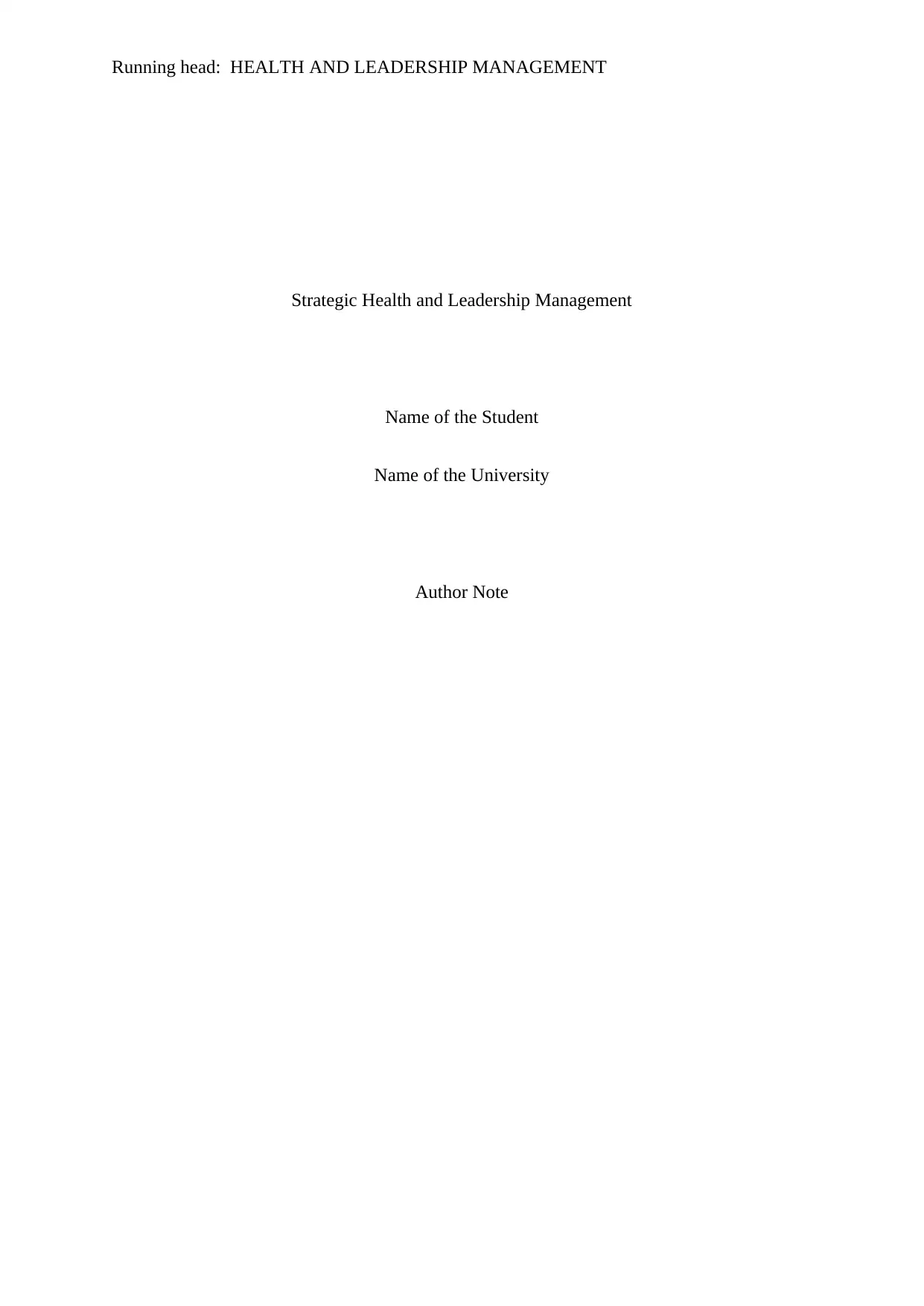
Running head: HEALTH AND LEADERSHIP MANAGEMENT
Strategic Health and Leadership Management
Name of the Student
Name of the University
Author Note
Strategic Health and Leadership Management
Name of the Student
Name of the University
Author Note
Secure Best Marks with AI Grader
Need help grading? Try our AI Grader for instant feedback on your assignments.
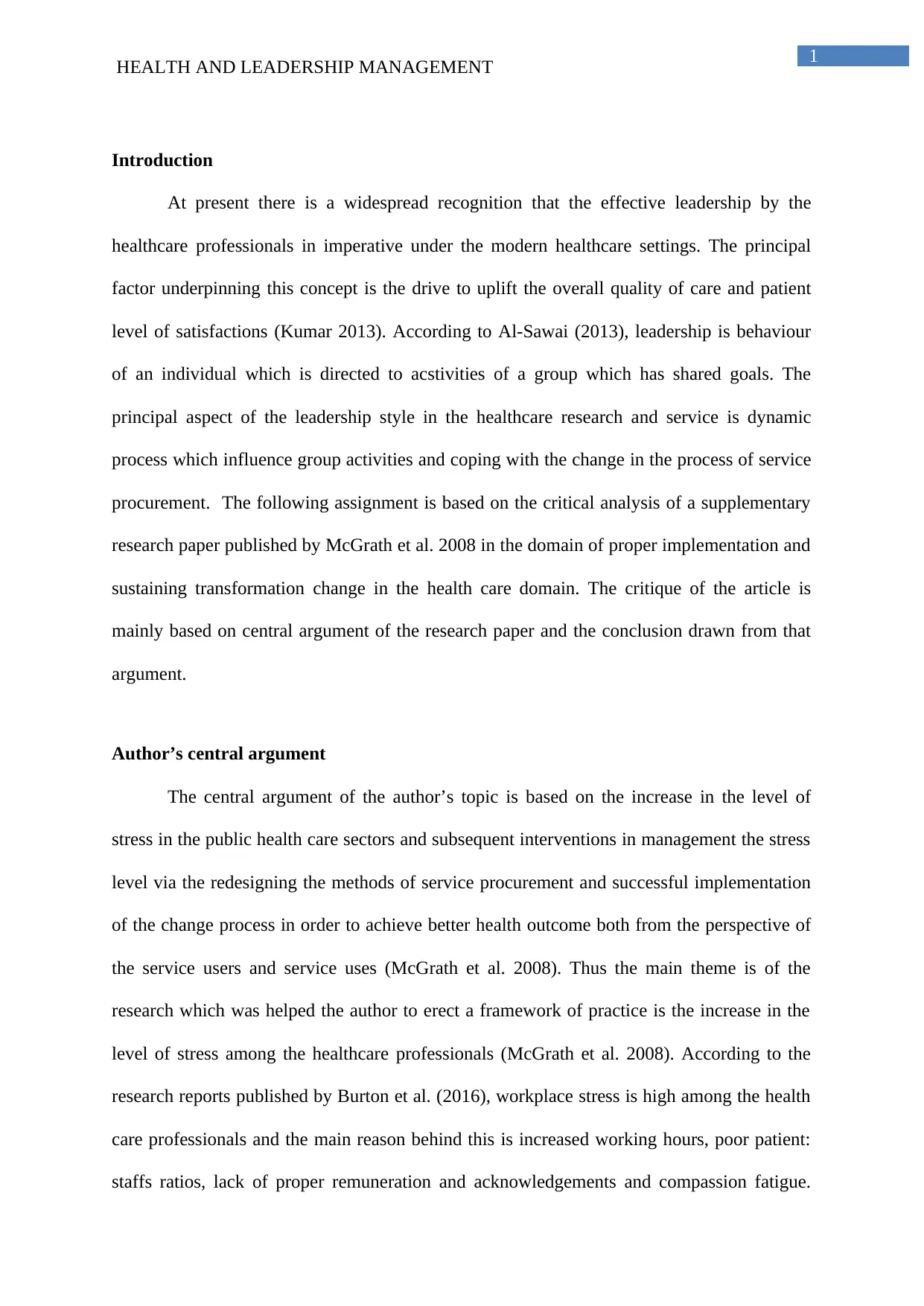
1
HEALTH AND LEADERSHIP MANAGEMENT
Introduction
At present there is a widespread recognition that the effective leadership by the
healthcare professionals in imperative under the modern healthcare settings. The principal
factor underpinning this concept is the drive to uplift the overall quality of care and patient
level of satisfactions (Kumar 2013). According to Al-Sawai (2013), leadership is behaviour
of an individual which is directed to acstivities of a group which has shared goals. The
principal aspect of the leadership style in the healthcare research and service is dynamic
process which influence group activities and coping with the change in the process of service
procurement. The following assignment is based on the critical analysis of a supplementary
research paper published by McGrath et al. 2008 in the domain of proper implementation and
sustaining transformation change in the health care domain. The critique of the article is
mainly based on central argument of the research paper and the conclusion drawn from that
argument.
Author’s central argument
The central argument of the author’s topic is based on the increase in the level of
stress in the public health care sectors and subsequent interventions in management the stress
level via the redesigning the methods of service procurement and successful implementation
of the change process in order to achieve better health outcome both from the perspective of
the service users and service uses (McGrath et al. 2008). Thus the main theme is of the
research which was helped the author to erect a framework of practice is the increase in the
level of stress among the healthcare professionals (McGrath et al. 2008). According to the
research reports published by Burton et al. (2016), workplace stress is high among the health
care professionals and the main reason behind this is increased working hours, poor patient:
staffs ratios, lack of proper remuneration and acknowledgements and compassion fatigue.
HEALTH AND LEADERSHIP MANAGEMENT
Introduction
At present there is a widespread recognition that the effective leadership by the
healthcare professionals in imperative under the modern healthcare settings. The principal
factor underpinning this concept is the drive to uplift the overall quality of care and patient
level of satisfactions (Kumar 2013). According to Al-Sawai (2013), leadership is behaviour
of an individual which is directed to acstivities of a group which has shared goals. The
principal aspect of the leadership style in the healthcare research and service is dynamic
process which influence group activities and coping with the change in the process of service
procurement. The following assignment is based on the critical analysis of a supplementary
research paper published by McGrath et al. 2008 in the domain of proper implementation and
sustaining transformation change in the health care domain. The critique of the article is
mainly based on central argument of the research paper and the conclusion drawn from that
argument.
Author’s central argument
The central argument of the author’s topic is based on the increase in the level of
stress in the public health care sectors and subsequent interventions in management the stress
level via the redesigning the methods of service procurement and successful implementation
of the change process in order to achieve better health outcome both from the perspective of
the service users and service uses (McGrath et al. 2008). Thus the main theme is of the
research which was helped the author to erect a framework of practice is the increase in the
level of stress among the healthcare professionals (McGrath et al. 2008). According to the
research reports published by Burton et al. (2016), workplace stress is high among the health
care professionals and the main reason behind this is increased working hours, poor patient:
staffs ratios, lack of proper remuneration and acknowledgements and compassion fatigue.
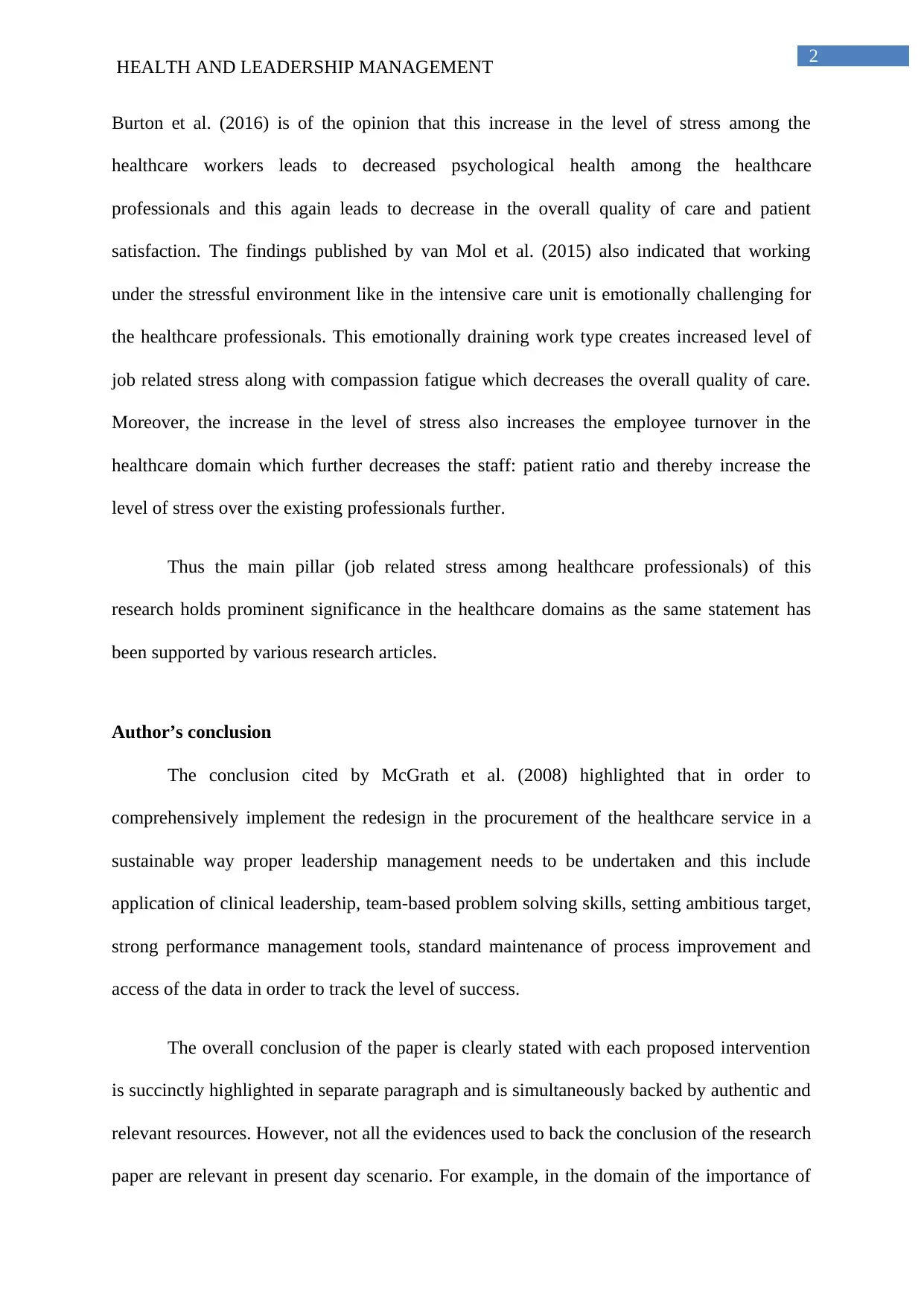
2
HEALTH AND LEADERSHIP MANAGEMENT
Burton et al. (2016) is of the opinion that this increase in the level of stress among the
healthcare workers leads to decreased psychological health among the healthcare
professionals and this again leads to decrease in the overall quality of care and patient
satisfaction. The findings published by van Mol et al. (2015) also indicated that working
under the stressful environment like in the intensive care unit is emotionally challenging for
the healthcare professionals. This emotionally draining work type creates increased level of
job related stress along with compassion fatigue which decreases the overall quality of care.
Moreover, the increase in the level of stress also increases the employee turnover in the
healthcare domain which further decreases the staff: patient ratio and thereby increase the
level of stress over the existing professionals further.
Thus the main pillar (job related stress among healthcare professionals) of this
research holds prominent significance in the healthcare domains as the same statement has
been supported by various research articles.
Author’s conclusion
The conclusion cited by McGrath et al. (2008) highlighted that in order to
comprehensively implement the redesign in the procurement of the healthcare service in a
sustainable way proper leadership management needs to be undertaken and this include
application of clinical leadership, team-based problem solving skills, setting ambitious target,
strong performance management tools, standard maintenance of process improvement and
access of the data in order to track the level of success.
The overall conclusion of the paper is clearly stated with each proposed intervention
is succinctly highlighted in separate paragraph and is simultaneously backed by authentic and
relevant resources. However, not all the evidences used to back the conclusion of the research
paper are relevant in present day scenario. For example, in the domain of the importance of
HEALTH AND LEADERSHIP MANAGEMENT
Burton et al. (2016) is of the opinion that this increase in the level of stress among the
healthcare workers leads to decreased psychological health among the healthcare
professionals and this again leads to decrease in the overall quality of care and patient
satisfaction. The findings published by van Mol et al. (2015) also indicated that working
under the stressful environment like in the intensive care unit is emotionally challenging for
the healthcare professionals. This emotionally draining work type creates increased level of
job related stress along with compassion fatigue which decreases the overall quality of care.
Moreover, the increase in the level of stress also increases the employee turnover in the
healthcare domain which further decreases the staff: patient ratio and thereby increase the
level of stress over the existing professionals further.
Thus the main pillar (job related stress among healthcare professionals) of this
research holds prominent significance in the healthcare domains as the same statement has
been supported by various research articles.
Author’s conclusion
The conclusion cited by McGrath et al. (2008) highlighted that in order to
comprehensively implement the redesign in the procurement of the healthcare service in a
sustainable way proper leadership management needs to be undertaken and this include
application of clinical leadership, team-based problem solving skills, setting ambitious target,
strong performance management tools, standard maintenance of process improvement and
access of the data in order to track the level of success.
The overall conclusion of the paper is clearly stated with each proposed intervention
is succinctly highlighted in separate paragraph and is simultaneously backed by authentic and
relevant resources. However, not all the evidences used to back the conclusion of the research
paper are relevant in present day scenario. For example, in the domain of the importance of
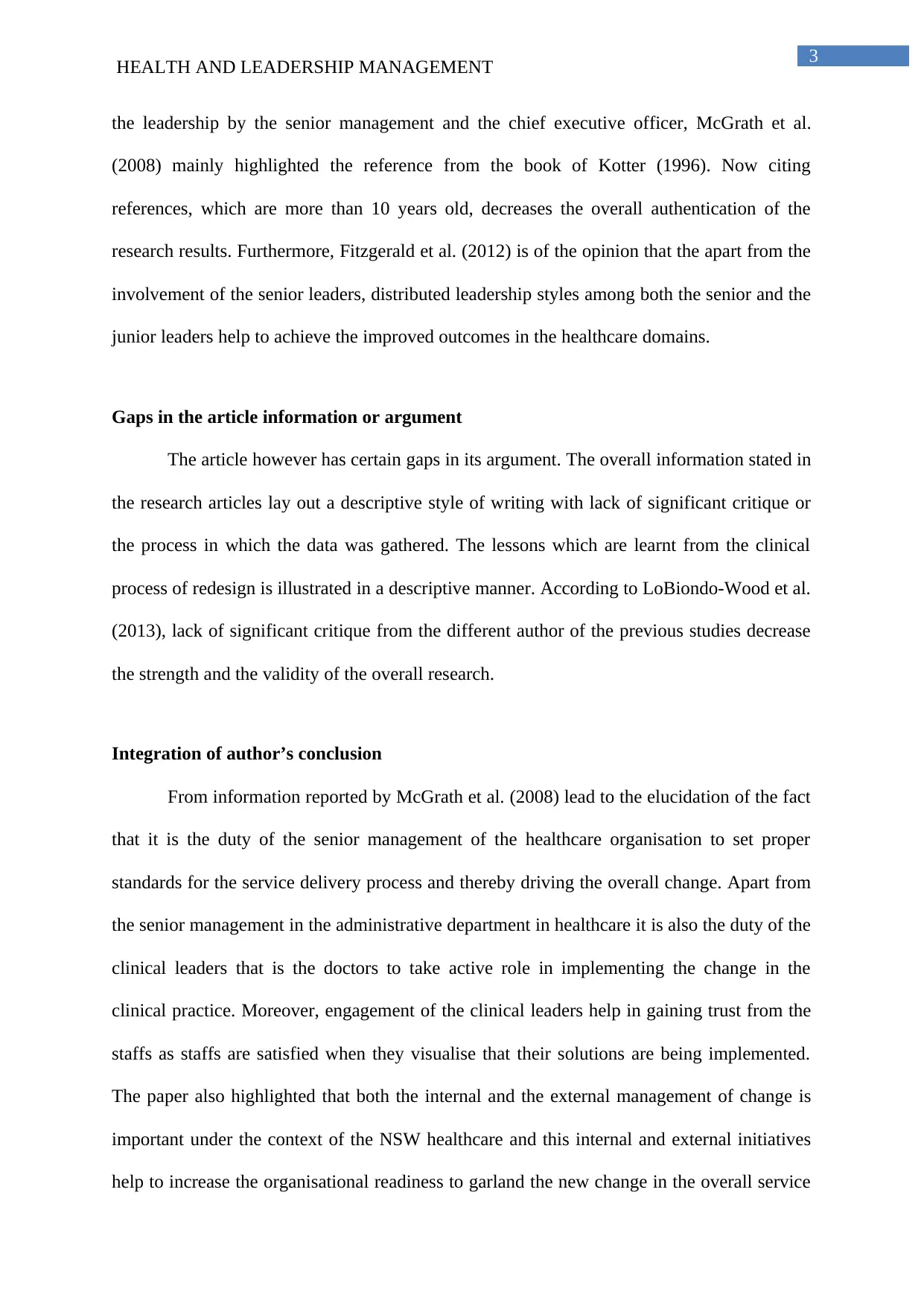
3
HEALTH AND LEADERSHIP MANAGEMENT
the leadership by the senior management and the chief executive officer, McGrath et al.
(2008) mainly highlighted the reference from the book of Kotter (1996). Now citing
references, which are more than 10 years old, decreases the overall authentication of the
research results. Furthermore, Fitzgerald et al. (2012) is of the opinion that the apart from the
involvement of the senior leaders, distributed leadership styles among both the senior and the
junior leaders help to achieve the improved outcomes in the healthcare domains.
Gaps in the article information or argument
The article however has certain gaps in its argument. The overall information stated in
the research articles lay out a descriptive style of writing with lack of significant critique or
the process in which the data was gathered. The lessons which are learnt from the clinical
process of redesign is illustrated in a descriptive manner. According to LoBiondo-Wood et al.
(2013), lack of significant critique from the different author of the previous studies decrease
the strength and the validity of the overall research.
Integration of author’s conclusion
From information reported by McGrath et al. (2008) lead to the elucidation of the fact
that it is the duty of the senior management of the healthcare organisation to set proper
standards for the service delivery process and thereby driving the overall change. Apart from
the senior management in the administrative department in healthcare it is also the duty of the
clinical leaders that is the doctors to take active role in implementing the change in the
clinical practice. Moreover, engagement of the clinical leaders help in gaining trust from the
staffs as staffs are satisfied when they visualise that their solutions are being implemented.
The paper also highlighted that both the internal and the external management of change is
important under the context of the NSW healthcare and this internal and external initiatives
help to increase the organisational readiness to garland the new change in the overall service
HEALTH AND LEADERSHIP MANAGEMENT
the leadership by the senior management and the chief executive officer, McGrath et al.
(2008) mainly highlighted the reference from the book of Kotter (1996). Now citing
references, which are more than 10 years old, decreases the overall authentication of the
research results. Furthermore, Fitzgerald et al. (2012) is of the opinion that the apart from the
involvement of the senior leaders, distributed leadership styles among both the senior and the
junior leaders help to achieve the improved outcomes in the healthcare domains.
Gaps in the article information or argument
The article however has certain gaps in its argument. The overall information stated in
the research articles lay out a descriptive style of writing with lack of significant critique or
the process in which the data was gathered. The lessons which are learnt from the clinical
process of redesign is illustrated in a descriptive manner. According to LoBiondo-Wood et al.
(2013), lack of significant critique from the different author of the previous studies decrease
the strength and the validity of the overall research.
Integration of author’s conclusion
From information reported by McGrath et al. (2008) lead to the elucidation of the fact
that it is the duty of the senior management of the healthcare organisation to set proper
standards for the service delivery process and thereby driving the overall change. Apart from
the senior management in the administrative department in healthcare it is also the duty of the
clinical leaders that is the doctors to take active role in implementing the change in the
clinical practice. Moreover, engagement of the clinical leaders help in gaining trust from the
staffs as staffs are satisfied when they visualise that their solutions are being implemented.
The paper also highlighted that both the internal and the external management of change is
important under the context of the NSW healthcare and this internal and external initiatives
help to increase the organisational readiness to garland the new change in the overall service
Secure Best Marks with AI Grader
Need help grading? Try our AI Grader for instant feedback on your assignments.
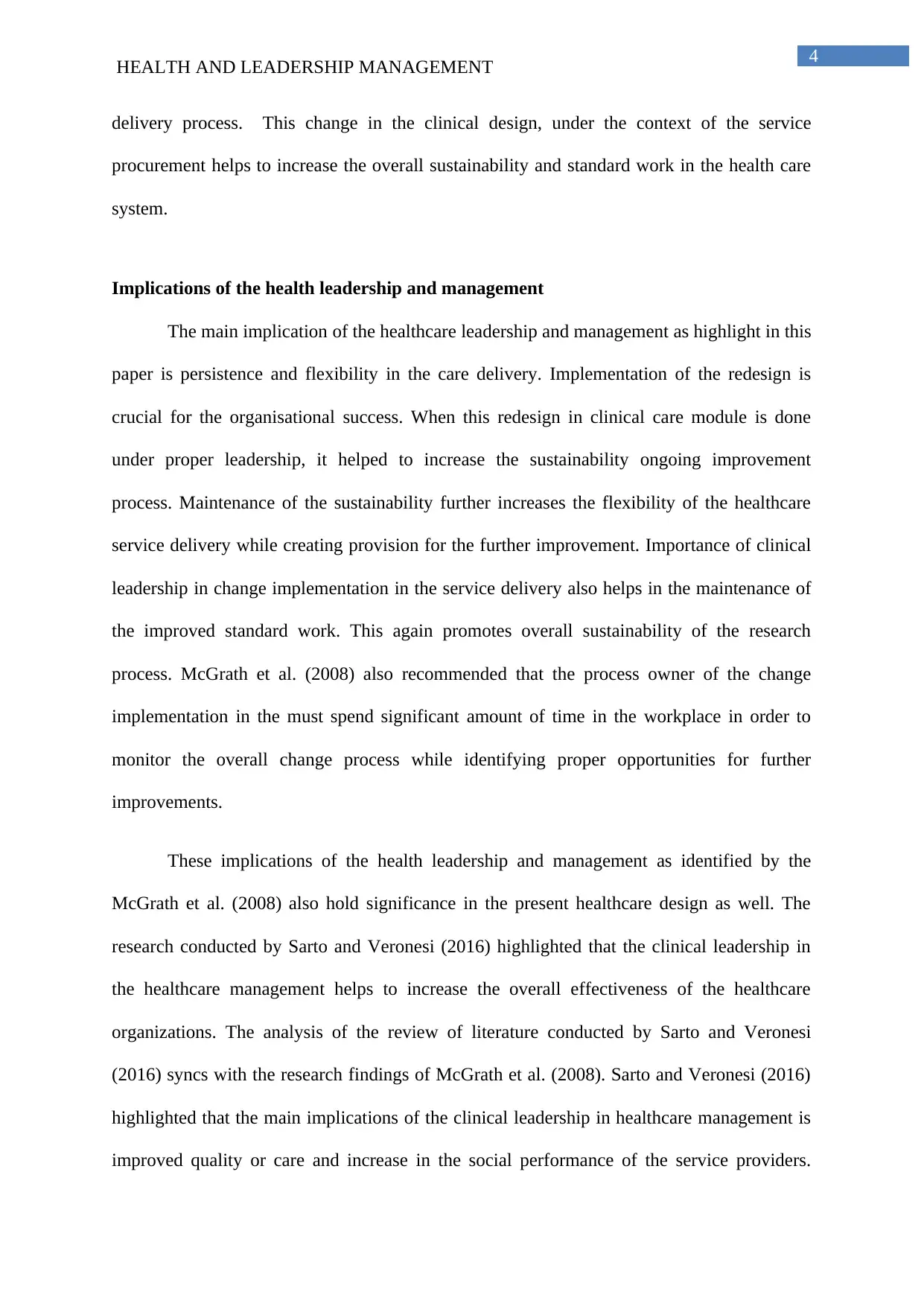
4
HEALTH AND LEADERSHIP MANAGEMENT
delivery process. This change in the clinical design, under the context of the service
procurement helps to increase the overall sustainability and standard work in the health care
system.
Implications of the health leadership and management
The main implication of the healthcare leadership and management as highlight in this
paper is persistence and flexibility in the care delivery. Implementation of the redesign is
crucial for the organisational success. When this redesign in clinical care module is done
under proper leadership, it helped to increase the sustainability ongoing improvement
process. Maintenance of the sustainability further increases the flexibility of the healthcare
service delivery while creating provision for the further improvement. Importance of clinical
leadership in change implementation in the service delivery also helps in the maintenance of
the improved standard work. This again promotes overall sustainability of the research
process. McGrath et al. (2008) also recommended that the process owner of the change
implementation in the must spend significant amount of time in the workplace in order to
monitor the overall change process while identifying proper opportunities for further
improvements.
These implications of the health leadership and management as identified by the
McGrath et al. (2008) also hold significance in the present healthcare design as well. The
research conducted by Sarto and Veronesi (2016) highlighted that the clinical leadership in
the healthcare management helps to increase the overall effectiveness of the healthcare
organizations. The analysis of the review of literature conducted by Sarto and Veronesi
(2016) syncs with the research findings of McGrath et al. (2008). Sarto and Veronesi (2016)
highlighted that the main implications of the clinical leadership in healthcare management is
improved quality or care and increase in the social performance of the service providers.
HEALTH AND LEADERSHIP MANAGEMENT
delivery process. This change in the clinical design, under the context of the service
procurement helps to increase the overall sustainability and standard work in the health care
system.
Implications of the health leadership and management
The main implication of the healthcare leadership and management as highlight in this
paper is persistence and flexibility in the care delivery. Implementation of the redesign is
crucial for the organisational success. When this redesign in clinical care module is done
under proper leadership, it helped to increase the sustainability ongoing improvement
process. Maintenance of the sustainability further increases the flexibility of the healthcare
service delivery while creating provision for the further improvement. Importance of clinical
leadership in change implementation in the service delivery also helps in the maintenance of
the improved standard work. This again promotes overall sustainability of the research
process. McGrath et al. (2008) also recommended that the process owner of the change
implementation in the must spend significant amount of time in the workplace in order to
monitor the overall change process while identifying proper opportunities for further
improvements.
These implications of the health leadership and management as identified by the
McGrath et al. (2008) also hold significance in the present healthcare design as well. The
research conducted by Sarto and Veronesi (2016) highlighted that the clinical leadership in
the healthcare management helps to increase the overall effectiveness of the healthcare
organizations. The analysis of the review of literature conducted by Sarto and Veronesi
(2016) syncs with the research findings of McGrath et al. (2008). Sarto and Veronesi (2016)
highlighted that the main implications of the clinical leadership in healthcare management is
improved quality or care and increase in the social performance of the service providers.
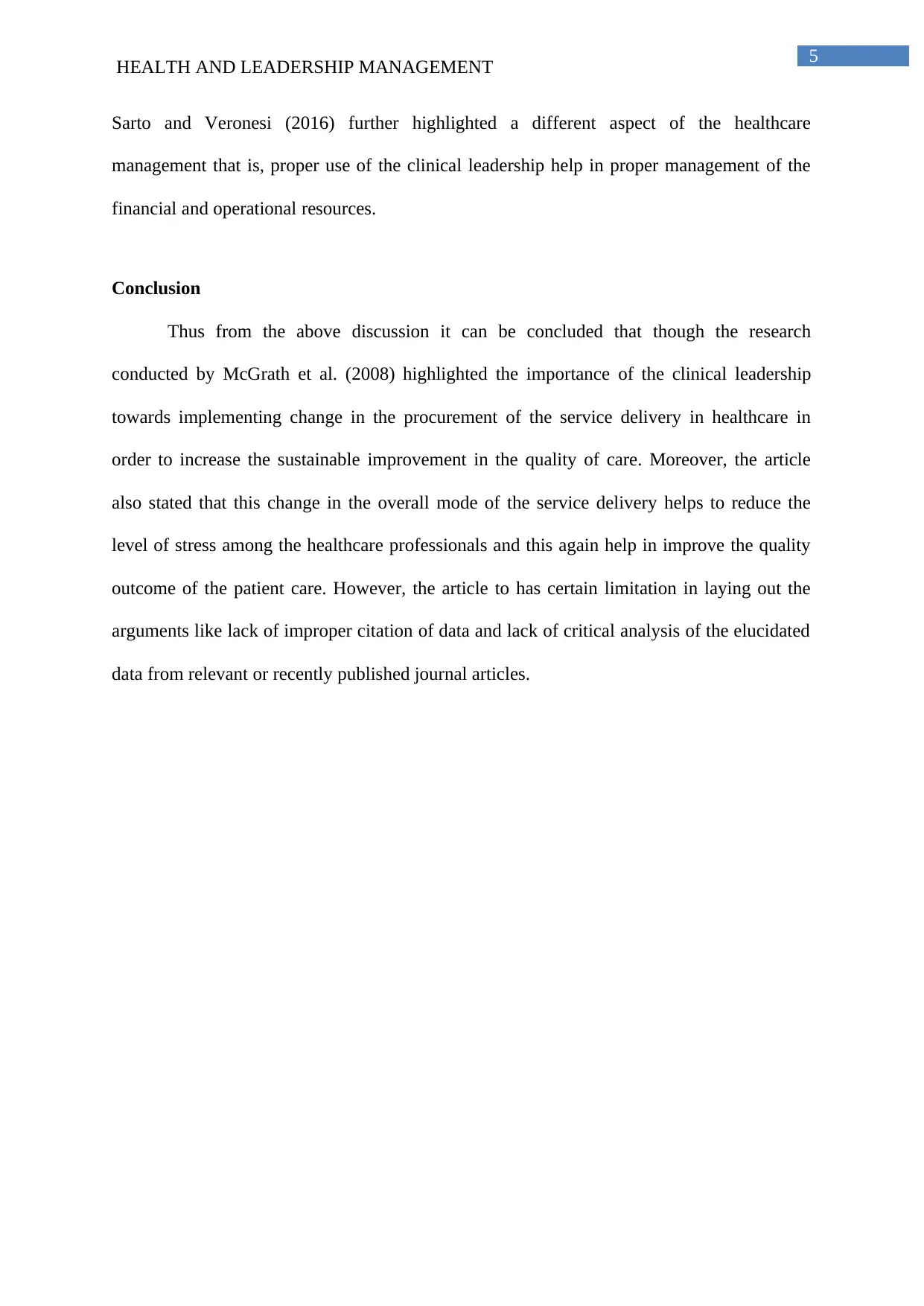
5
HEALTH AND LEADERSHIP MANAGEMENT
Sarto and Veronesi (2016) further highlighted a different aspect of the healthcare
management that is, proper use of the clinical leadership help in proper management of the
financial and operational resources.
Conclusion
Thus from the above discussion it can be concluded that though the research
conducted by McGrath et al. (2008) highlighted the importance of the clinical leadership
towards implementing change in the procurement of the service delivery in healthcare in
order to increase the sustainable improvement in the quality of care. Moreover, the article
also stated that this change in the overall mode of the service delivery helps to reduce the
level of stress among the healthcare professionals and this again help in improve the quality
outcome of the patient care. However, the article to has certain limitation in laying out the
arguments like lack of improper citation of data and lack of critical analysis of the elucidated
data from relevant or recently published journal articles.
HEALTH AND LEADERSHIP MANAGEMENT
Sarto and Veronesi (2016) further highlighted a different aspect of the healthcare
management that is, proper use of the clinical leadership help in proper management of the
financial and operational resources.
Conclusion
Thus from the above discussion it can be concluded that though the research
conducted by McGrath et al. (2008) highlighted the importance of the clinical leadership
towards implementing change in the procurement of the service delivery in healthcare in
order to increase the sustainable improvement in the quality of care. Moreover, the article
also stated that this change in the overall mode of the service delivery helps to reduce the
level of stress among the healthcare professionals and this again help in improve the quality
outcome of the patient care. However, the article to has certain limitation in laying out the
arguments like lack of improper citation of data and lack of critical analysis of the elucidated
data from relevant or recently published journal articles.
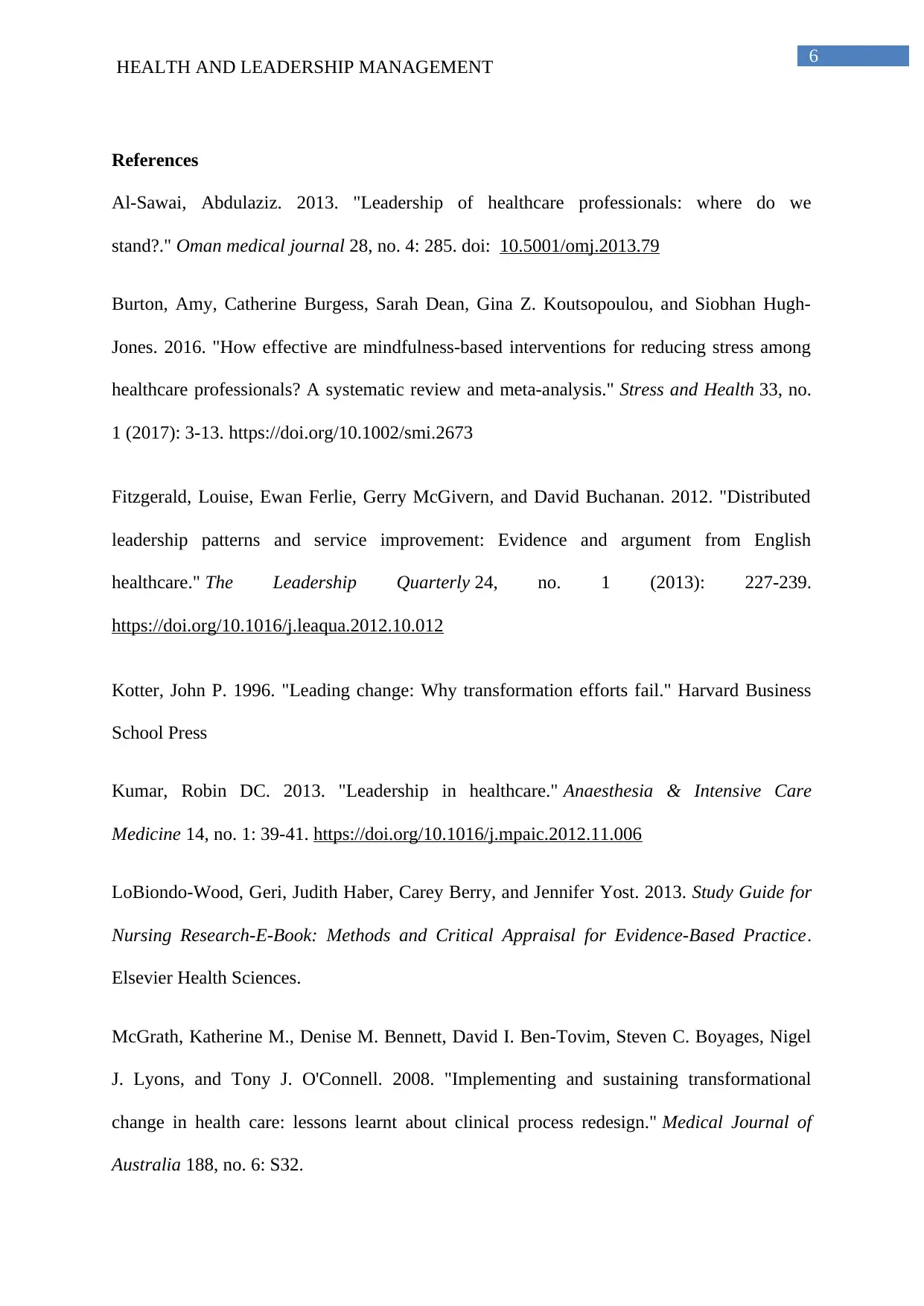
6
HEALTH AND LEADERSHIP MANAGEMENT
References
Al-Sawai, Abdulaziz. 2013. "Leadership of healthcare professionals: where do we
stand?." Oman medical journal 28, no. 4: 285. doi: 10.5001/omj.2013.79
Burton, Amy, Catherine Burgess, Sarah Dean, Gina Z. Koutsopoulou, and Siobhan Hugh‐
Jones. 2016. "How effective are mindfulness‐based interventions for reducing stress among
healthcare professionals? A systematic review and meta‐analysis." Stress and Health 33, no.
1 (2017): 3-13. https://doi.org/10.1002/smi.2673
Fitzgerald, Louise, Ewan Ferlie, Gerry McGivern, and David Buchanan. 2012. "Distributed
leadership patterns and service improvement: Evidence and argument from English
healthcare." The Leadership Quarterly 24, no. 1 (2013): 227-239.
https://doi.org/10.1016/j.leaqua.2012.10.012
Kotter, John P. 1996. "Leading change: Why transformation efforts fail." Harvard Business
School Press
Kumar, Robin DC. 2013. "Leadership in healthcare." Anaesthesia & Intensive Care
Medicine 14, no. 1: 39-41. https://doi.org/10.1016/j.mpaic.2012.11.006
LoBiondo-Wood, Geri, Judith Haber, Carey Berry, and Jennifer Yost. 2013. Study Guide for
Nursing Research-E-Book: Methods and Critical Appraisal for Evidence-Based Practice.
Elsevier Health Sciences.
McGrath, Katherine M., Denise M. Bennett, David I. Ben-Tovim, Steven C. Boyages, Nigel
J. Lyons, and Tony J. O'Connell. 2008. "Implementing and sustaining transformational
change in health care: lessons learnt about clinical process redesign." Medical Journal of
Australia 188, no. 6: S32.
HEALTH AND LEADERSHIP MANAGEMENT
References
Al-Sawai, Abdulaziz. 2013. "Leadership of healthcare professionals: where do we
stand?." Oman medical journal 28, no. 4: 285. doi: 10.5001/omj.2013.79
Burton, Amy, Catherine Burgess, Sarah Dean, Gina Z. Koutsopoulou, and Siobhan Hugh‐
Jones. 2016. "How effective are mindfulness‐based interventions for reducing stress among
healthcare professionals? A systematic review and meta‐analysis." Stress and Health 33, no.
1 (2017): 3-13. https://doi.org/10.1002/smi.2673
Fitzgerald, Louise, Ewan Ferlie, Gerry McGivern, and David Buchanan. 2012. "Distributed
leadership patterns and service improvement: Evidence and argument from English
healthcare." The Leadership Quarterly 24, no. 1 (2013): 227-239.
https://doi.org/10.1016/j.leaqua.2012.10.012
Kotter, John P. 1996. "Leading change: Why transformation efforts fail." Harvard Business
School Press
Kumar, Robin DC. 2013. "Leadership in healthcare." Anaesthesia & Intensive Care
Medicine 14, no. 1: 39-41. https://doi.org/10.1016/j.mpaic.2012.11.006
LoBiondo-Wood, Geri, Judith Haber, Carey Berry, and Jennifer Yost. 2013. Study Guide for
Nursing Research-E-Book: Methods and Critical Appraisal for Evidence-Based Practice.
Elsevier Health Sciences.
McGrath, Katherine M., Denise M. Bennett, David I. Ben-Tovim, Steven C. Boyages, Nigel
J. Lyons, and Tony J. O'Connell. 2008. "Implementing and sustaining transformational
change in health care: lessons learnt about clinical process redesign." Medical Journal of
Australia 188, no. 6: S32.
Paraphrase This Document
Need a fresh take? Get an instant paraphrase of this document with our AI Paraphraser
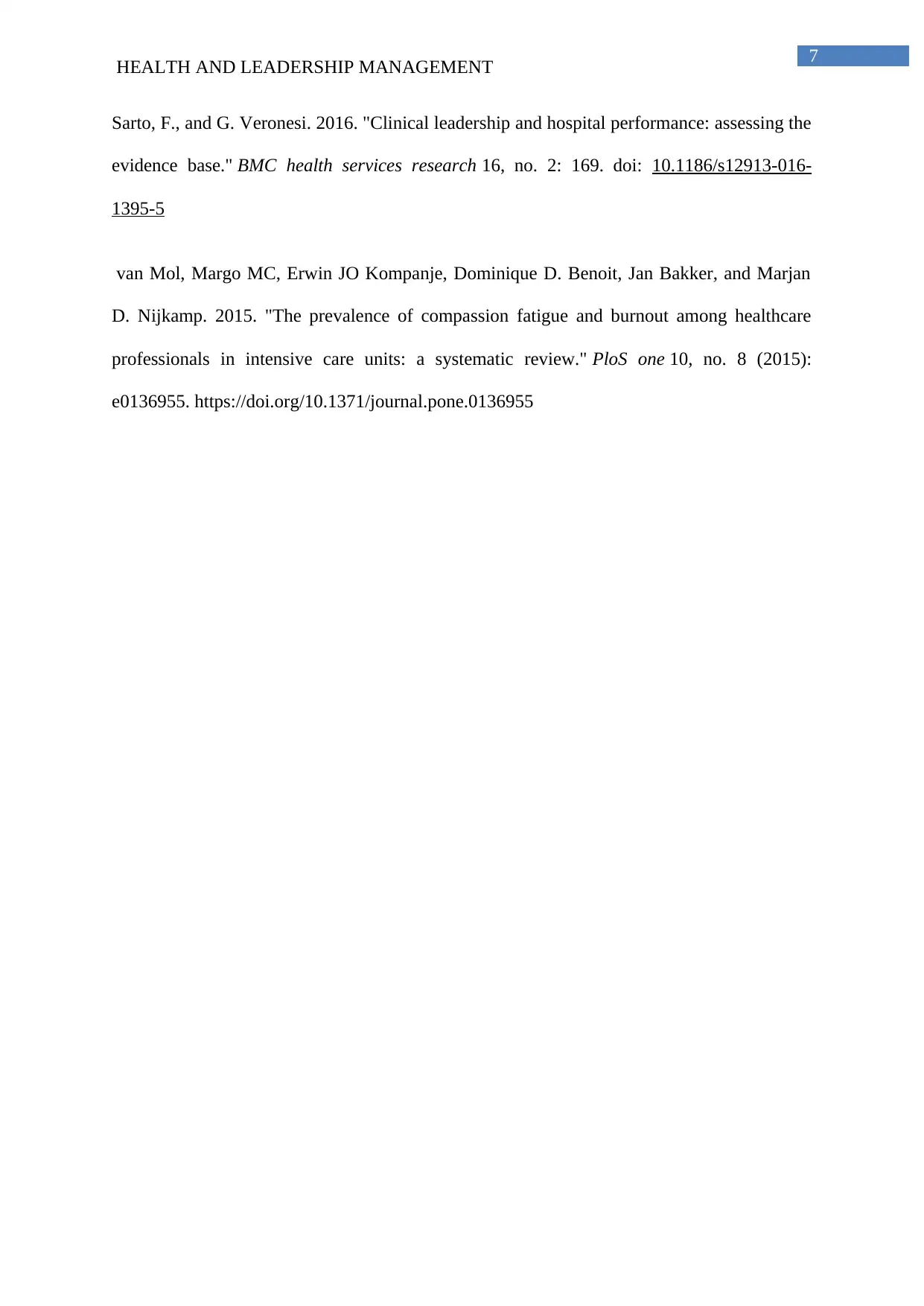
7
HEALTH AND LEADERSHIP MANAGEMENT
Sarto, F., and G. Veronesi. 2016. "Clinical leadership and hospital performance: assessing the
evidence base." BMC health services research 16, no. 2: 169. doi: 10.1186/s12913-016-
1395-5
van Mol, Margo MC, Erwin JO Kompanje, Dominique D. Benoit, Jan Bakker, and Marjan
D. Nijkamp. 2015. "The prevalence of compassion fatigue and burnout among healthcare
professionals in intensive care units: a systematic review." PloS one 10, no. 8 (2015):
e0136955. https://doi.org/10.1371/journal.pone.0136955
HEALTH AND LEADERSHIP MANAGEMENT
Sarto, F., and G. Veronesi. 2016. "Clinical leadership and hospital performance: assessing the
evidence base." BMC health services research 16, no. 2: 169. doi: 10.1186/s12913-016-
1395-5
van Mol, Margo MC, Erwin JO Kompanje, Dominique D. Benoit, Jan Bakker, and Marjan
D. Nijkamp. 2015. "The prevalence of compassion fatigue and burnout among healthcare
professionals in intensive care units: a systematic review." PloS one 10, no. 8 (2015):
e0136955. https://doi.org/10.1371/journal.pone.0136955
1 out of 8
Related Documents
Your All-in-One AI-Powered Toolkit for Academic Success.
+13062052269
info@desklib.com
Available 24*7 on WhatsApp / Email
![[object Object]](/_next/static/media/star-bottom.7253800d.svg)
Unlock your academic potential
© 2024 | Zucol Services PVT LTD | All rights reserved.





